These guidelines set out the basic rules on how to use the MSC label on product packaging, restaurant menus, fish counters and promotional material.
The MSC brand elements
1. The MSC label
The MSC label comprises of six features, which may not be separated from each other or altered in any way:
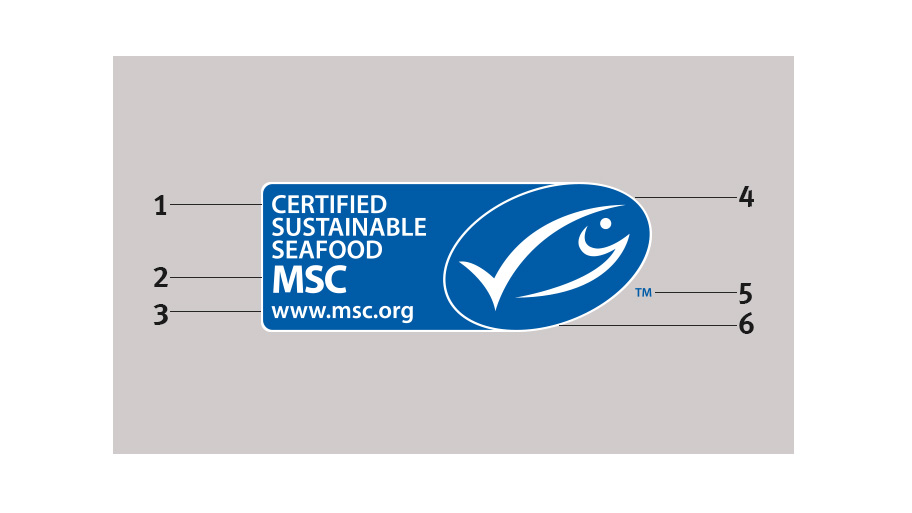
- The phrase 'Certified sustainable seafood’
- The letters MSC, the abbreviation of the Marine Stewardship Council
- The MSC’s website address
- The oval fish checkmark
- The letters TM indicate that this label is a trademark
- The white keyline which outlines the fish checkmark and the label
2. The MSC Chain of Custody Code
Every MSC labelled product must carry a Chain of Custody code following the format of MSC-C-xxxxx that refers to the producer of the product. It can be displayed anywhere on your materials and must be readable. The code will be provided by your certifier or certified supplier.
It is the owner’s responsibility to make sure that the product has been correctly registered with the MSC, under a valid licence.
3. The MSC claim
The MSC claim must accompany the MSC label. You can choose from the following claim text versions.
For products:
- Thank you for choosing seafood that has met the MSC’s global standard for sustainability. Together we can help protect fish stocks for the future. www.msc.org
- This product comes from a fishery that has been independently certified to the MSC’s standard for a well-managed and sustainable fishery. www.msc.org
- The [insert seafood species] in this product comes from a fishery that has been independently certified to the MSC’s standard for a well-managed and sustainable fishery. www.msc.org
- This seafood has met the MSC's global standard for sustainability. www.msc.org
- From an MSC certified sustainable fishery. www.msc.org
The claim should be shown in the language(s) of the country where the product or material is sold or published.
See the full list of MSC claim translations
The MSC is not responsible for validating any additional claims, legal requirements or other labelling guidelines.
Formats
The MSC label is available in two formats: vertical (portrait) and horizontal (landscape).
If you are using the MSC label on top of an image or dark coloured background use the version with the white trademark symbol (TM). For light or white backgrounds use the standard version of the TM symbol in blue.
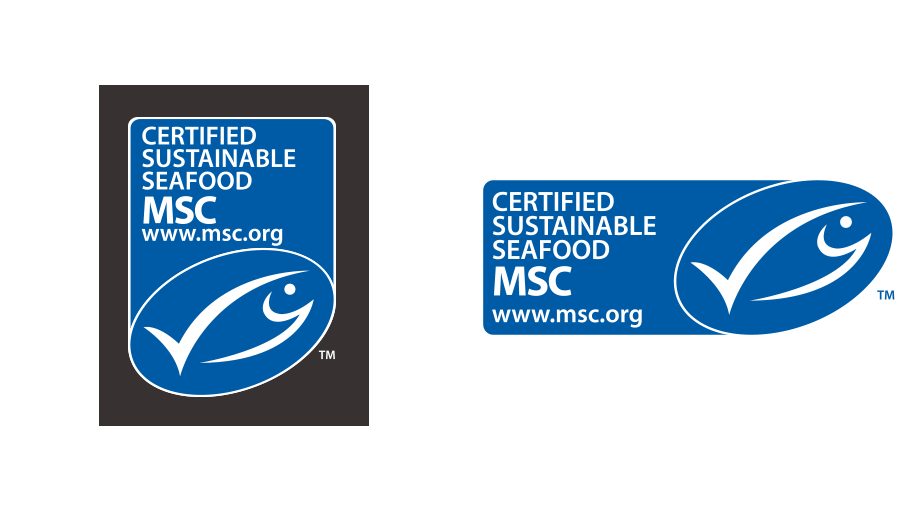
Colour
Consumers recognise and look for the 'blue fish label'. It is important that you use the correct version of the MSC blue colour to ensure consistency, trust and recognition. In exceptional circumstances such as if your packaging is black and white, or the same Pantone blue, you may use the solid monotone version. But be advised this will affect consumer recognition.
MSC blue | |
| Pantone | 286 |
| CMYK | 100 60 0 2 |
| RGB | 0 93 170 |
| Hex | #005DAA |
The white keyline which outlines the fish checkmark and the MSC label as a whole must always be displayed. No other colour may be used.
Size and clear space
The minimum size for the horizontal label is 10mm H x 26.1mm W
The minimum size for the vertical label is 14mm W x 18.8mm H
Always make sure you scale the MSC label up or down proportionately.
There is no maximum size restriction for display of the MSC label or its variations.
When the MSC label is produced at its minimum size the clear space around it must be:
- at least 2mm for product specific text (such as species, weight, ingredients).
- at least 5mm for general design elements (such as brand names, logos) where the MSC label could be associated with the host brand.
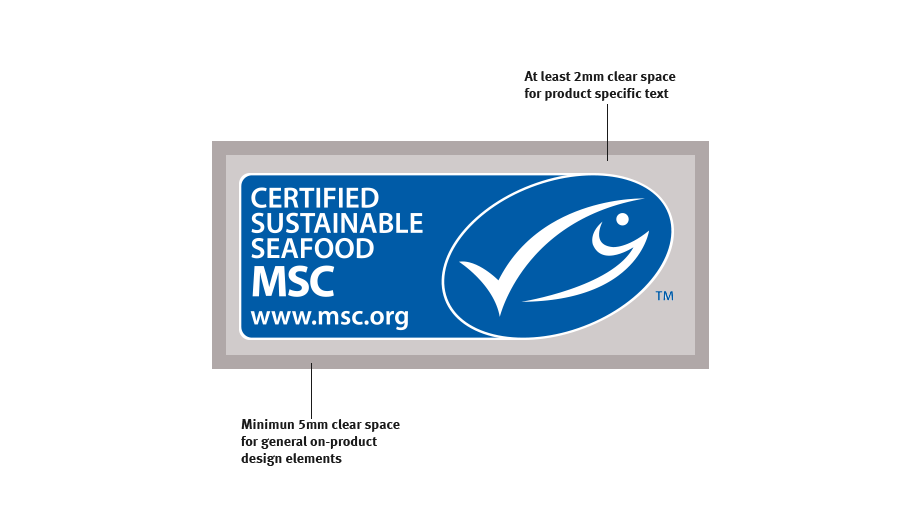
When the MSC label is reproduced at larger sizes it must be surrounded by a minimum clear space at 10% of the label height (vertical) or width (horizontal). Always allow as much space as possible.
Correct use
Use the logo files supplied when you request to use our label. Make sure that the MSC label and Marine Stewardship Council's name are never displayed in a way that:
- confuses consumers as to the association of the MSC with other brands or logos
- suggests or implies that non-certified seafood is MSC certified
- creates an association with products that are not from a fishery certified to the MSC standard
Do not modify our logo or attempt to create the MSC label yourself. Do not:
- display the MSC label without the trademark symbol (TM)
- remove the white keyline
- distort the shape of the MSC label
- change the colours of the MSC label
- alter the design, lock-up, or separate the elements of the MSC label
- tilt the MSC label
- place items or text over the MSC label
Examples of incorrect use of the MSC label
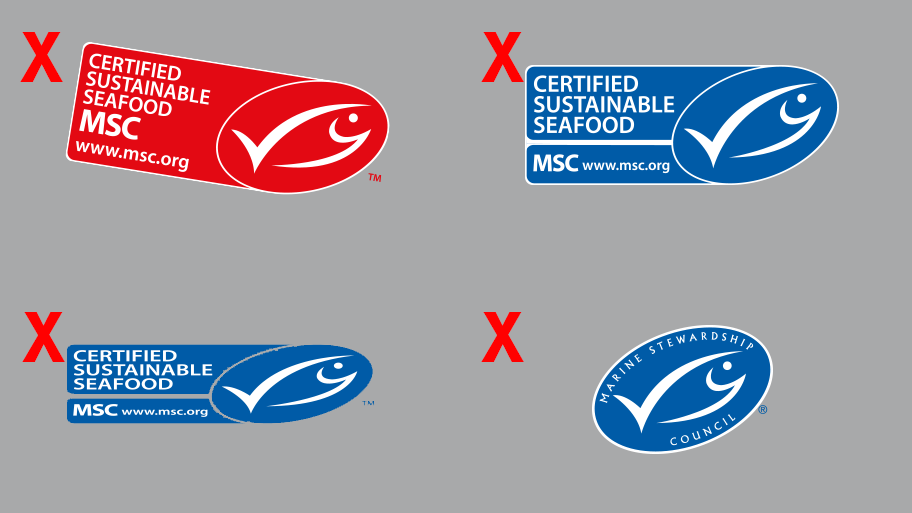
On product use
When using the MSC label on packaging, each product label should display the MSC label, chain of custody code and relevant claim.
- The MSC label must appear on the front of the packaging to ensure it is immediately visible to consumers.
- Every MSC labelled product must carry a Chain of Custody code. It can be displayed anywhere on the packaging and should be readable.
- When the MSC label is used on a product, it must always be accompanied by the MSC claim. The MSC claim can go anywhere on a pack and is available in five versions
The acronym MSC or the Marine Stewardship Council are not allowed on their own. You may not use images of non-certified species or non-certified fishing activity on product packaging. The trade name of a product should not refer to non-certified species.
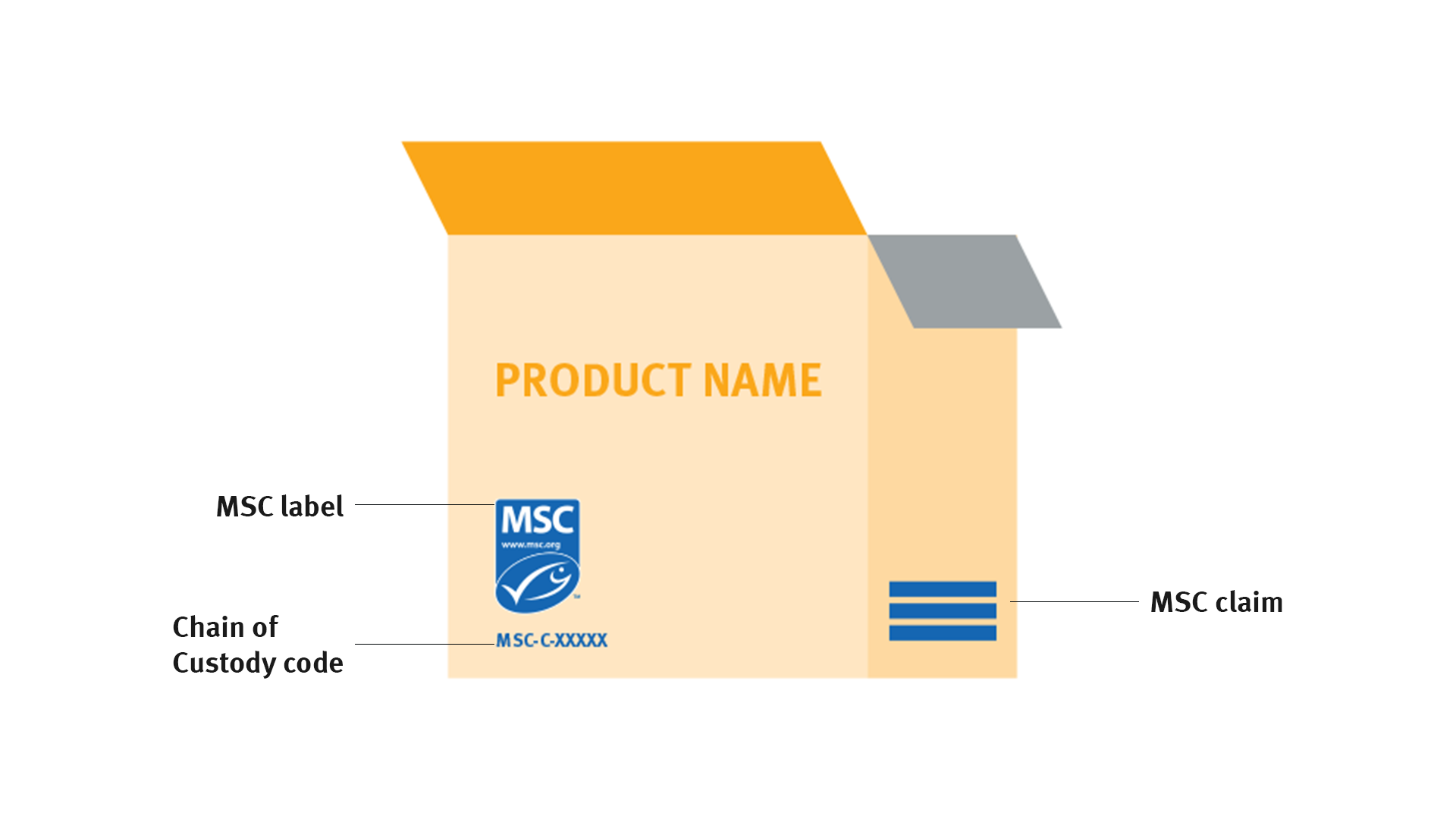
Menus
To be able to promote your dish as MSC certified its seafood content must be at least 95 per cent MSC certified. When designing your menu, we’ve provided 4 options as a starting point.
Option 1 – recommended
Place the MSC oval next to your MSC certified dishes and use the standard label as a key. The Chain of Custody code of your restaurant or catering firm and the MSC claim: 'Seafood with this mark comes from an MSC certified sustainable fishery. www.msc.org' can be placed anywhere on the menu.

Option 2
Use the initials ‘MSC’ for identifying your MSC certified dishes and the standard label as a key. The Chain of Custody code of your restaurant or catering firm and the MSC claim: 'Seafood with this mark comes from an MSC certified sustainable fishery. www.msc.org' can be placed anywhere on the menu.

Option 3
Use the MSC oval as both, indicator next to your MSC certified dishes and key. The Chain of Custody code of your restaurant or catering firm and the MSC claim: 'Seafood with this mark comes from an MSC certified sustainable fishery. www.msc.org' can be placed anywhere on the menu. You may also use a black and white or black and white inverted oval when choosing option 3.

Option 4
To explain which species on your menu are MSC certified without using the oval indicator, display the standard label with specific claim identifying MSC certified species. Your Chain of Custody code and the MSC claim: 'All our [species] comes from an MSC certified sustainable fishery. www.msc.org’ can be placed anywhere on the menu.

Fresh fish counters
When promoting MSC certified seafood at your fresh fish counter, each price tag should display the MSC label, claim and chain of custody code.
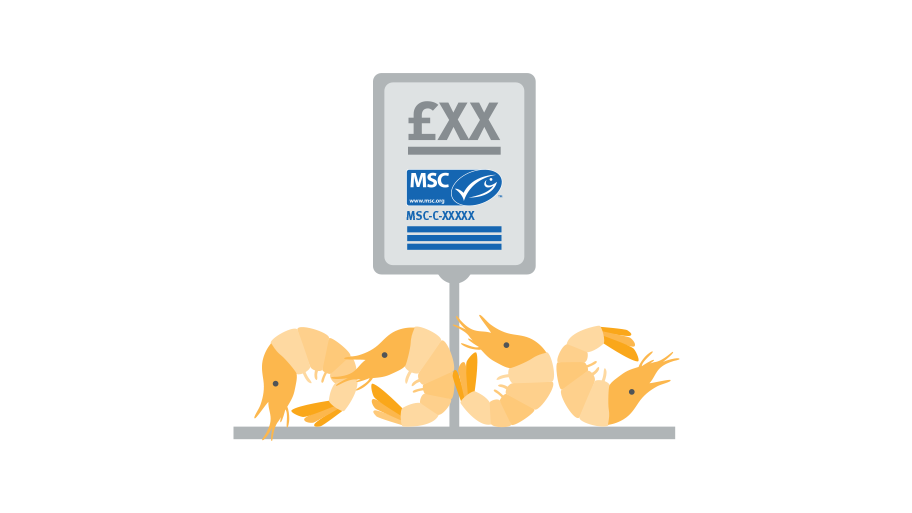
You may use a sticker or clip to attach the MSC elements to the price tag.
If there’s not enough space, you can display the MSC label on the price tag and place a poster or display stand at your fish counter showing the MSC label, claim and chain of custody code.
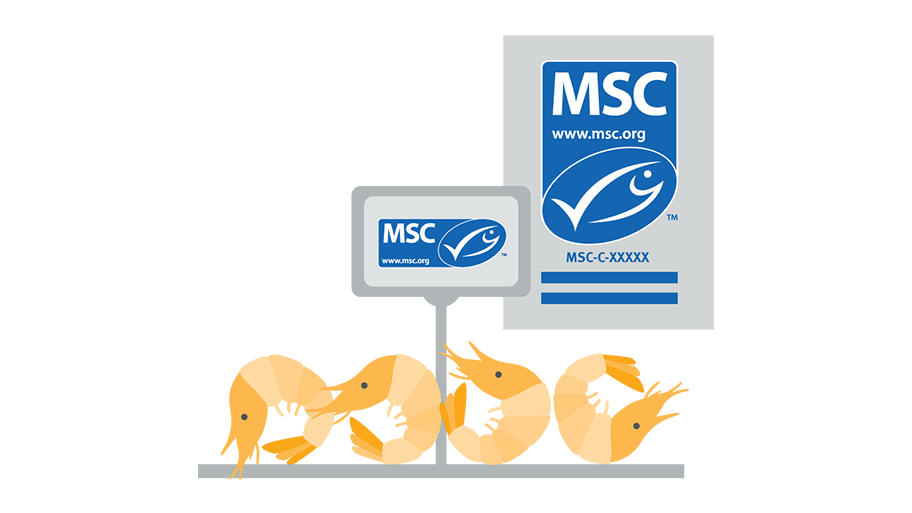
Use of fish tags
If you would like to identify a product as MSC certified by using a fish tag, band or similar mark, specific rules apply:
- The tag or band must be consumer ready and tamper proof, i.e. impossible to remove and for single use only
- The tag or band must be applied to a clearly visible part of the product
- The tag or band must display:
– the species name
– the MSC label
– the Chain of Custody code of the company attaching the tag or band
– a version of the MSC claim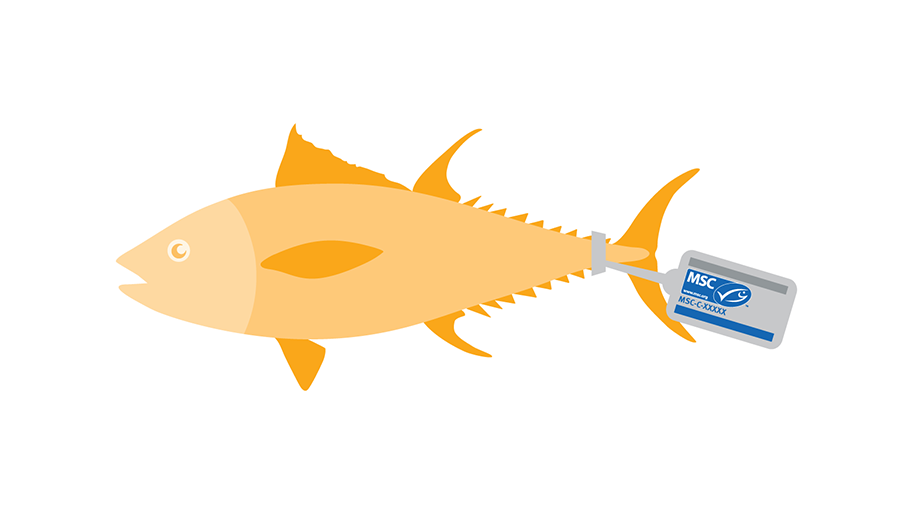
As a consumer-facing product, a tagged seafood item can be sold by a retailer without the retailer needing to have MSC Chain of Custody certification.
Promotional use
Seafood products may only be promoted as MSC certified sustainable if they:
- are covered by Chain of Custody certification
- have previously been approved by the MSC's Licensing Team
- display the MSC label on the pack shot. Exemption for Modified Atmosphere Packaging (MAP), fresh fish and caterer's dishes.
When using imagery of fishing vessels, please note that these are considered part of the certification and need to accurately represent the fishing method of the advertised species.
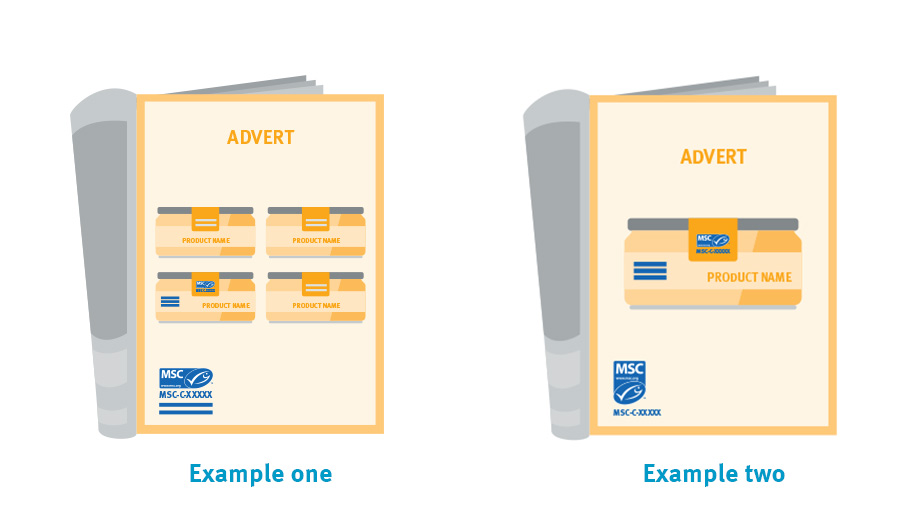
Example one: if your company sells MSC certified and non-certified seafood or publishes materials that refer to both the MSC label must be accompanied by supporting text to make it clear to consumers which products are MSC certified.
Example two: if your materials refer to MSC certified products only, or all seafood sold by your company is MSC labelled, you may use the MSC label without additional explanatory text. It must be accompanied by the Chain of Custody code of your company – if it exists.
Price lists and catalogues
On price lists and catalogues you can choose to use the standard MSC label or the MSC oval, specifically designed for list views.
Place the MSC label or MSC oval next to your products that are MSC certified. As a key, please use the standard MSC label with explanatory text: ‘Seafood with this mark comes from an MSC certified sustainable fishery. www.msc.org’ and – if it exists – Chain of Custody code of your company on the price list or catalogue.
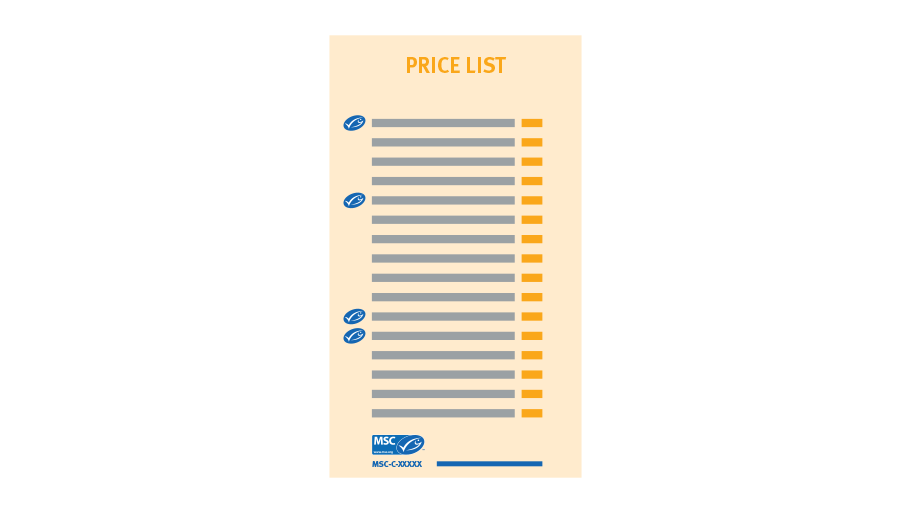
Promoting Chain of Custody certification
If you would like to promote your organisation’s Chain of Custody certification without making any reference to specific products, you must use the MSC label with supporting text and your Chain of Custody code.
Approved wording:
“We are MSC certified. Look for the blue MSC label.”
We do allow room for flexibility (eg. due to space constraints) providing the meaning is not lost.
Approved supporting text:
When using the MSC label with supporting text, the text must be adjacent to and clearly associated with the label.
You may develop your own wording to accompany the MSC label, providing you seek approval from the MSC before publishing.
Access visual assets and messaging
Independent research by Globescan shows that simlpy labelling or communicating is not enough to change consumer behaviour. By doing both, you can grow consumer loyalty and trust. To help, we provide year round opportunities to get involved in campaigns, toolkits and inspiration, money can't buy assets and messaging advice. View the MSC Multimedia Library
FAQs
Which Chain of Custody code should I use?
A product should always display the Chain of Custody code (CoC code) of the owner of the seafood at the time of placing the product into its MSC labelled packaging.
It is the owner’s responsibility to make sure that the product has been correctly registered with the MSC’s Licensing Team, under a valid licence.
Examples of supply chains to illustrate the application of the rule
Scenario 1: Processor placing product into MSC labelled packaging under processor or retail own brand, sells to retailer = CoC code on packaging: Processor’s
Scenario 2: Processor sells non MSC labelled seafood to retailer that applies label on fish counter or processes in-store = CoC code on packaging: Retailer’s
Scenario 3: Processor sells non-MSC labelled seafood to restaurant that applies label on menu = CoC code on menu: Restaurant’s
Scenario 4: Contract caterer operates the canteen of a commercial client and places the label on menu with the consent of the client = CoC code on menu: Contract caterer’s
Which company is the licence holder?
The licence holder is the company that is the owner of the seafood at the time the MSC label is applied.
The licence holder is responsible for annual fee and royalty payments.
Examples of supply chains to illustrate the application of the rule
Note: if the processor does not want to be the licence holder, the brand owner needs to seek permission from the MSC's Licensing Team to be the licence holder.
Scenario 1: Processor places product into MSC labelled packaging (under processor or retail own brand) and sells to retailer = The processor is the licensee
Scenario 2: Subcontractor places product into MSC labelled packaging on behalf of the processor = The processor is the licensee
Scenario 3: Processor places product into MSC labelled packaging (under brand owner own brand) and sells to a brand owner = The processor is the licensee
Scenario 4: Processor sells certified but non MSC labelled seafood to retailer who then applies label on fish counter or processes in-store = The retailer is the licensee
Scenario 5: Processor sells certified but non MSC labelled seafood to restaurant that then applies label on menu = The restaurant is the licensee
Scenario 6: Contract caterer operates the canteen of a commercial client and places the label on menu with the consent of the client = The contract caterer is the licensee
What about Non-MSC certified seafood ingredients?
A product carrying the MSC label may contain 5% non-certified seafood in the total seafood content.
You can calculate the percentage of non-MSC certified seafood ingredients in a product by using the following formula:
Total net weight of non-MSC certified seafood ingredients*
Divided by
Total weight of the combined MSC certified and non-MSC certified seafood ingredients in the finished product*
*excluding water and added salt
If your seafood product contains more than 5% non-MSC certified seafood:
✗ You cannot show the MSC label on the packaging at all
✗ You may not use any text referring to the MSC on the front of the packaging
✓ Instead, please use version 3 of the MSC claim on the back of the packaging. It references the seafood ingredients which are actually certified:
Version 3: The [insert seafood species] in this product comes from a fishery that
has been independently certified to the MSC’s standard for a well-managed and
sustainable fishery. www.msc.org
✓ Don’t forget to display the MSC Chain of Custody code next to the claim.
✓ You need to specify in the ingredients section which seafood ingredient
is certified. For example ‘MSC certified Alaska salmon’ or ‘Alaska salmon – MSC certified’
Royalties are still applicable on consumer-facing products
MSC label guidance documents
All documents related to MSC label use.
| Description: | Policy on labelling instructions where ASC and MSC certified products are mixed to make up the main seafood content of a product |
|---|---|
| Language: | English |
| Date of issue: | 05 June 2023 |
| Description: | Basic rules for the use of the MSC label on packaging, menus, fish counters and promotional materials. |
|---|---|
| Language: | English |
| Date of issue: | 13 April 2023 |
| Description: | Examples illustrating how to calculate the percentage of a non-MSC-certified ingredient in a mixed product containing both MSC- and non-MSC-certified seafood. |
|---|---|
| Language: | English |
| Date of issue: | 27 October 2016 |
| Description: | This document gives examples on how to promote the availability of MSC certified seafood on (in-store) leaflets using the MSC ecolabel. |
|---|---|
| Language: | English |
| Date of issue: | 18 August 2016 |
| Description: | Policy on waiving MSC ecolabel fees for educational use. |
|---|---|
| Language: | English |
| Date of issue: | 18 August 2016 |
| Description: | Policy on using temporary stickers to display the MSC ecolabel on seafood products. |
|---|---|
| Language: | English |
| Date of issue: | 26 July 2016 |
| Description: | Policy on how to use the MSC ecolabel on multi-packs, i.e. packages sold as one unit but consisting of individually packed items. |
|---|---|
| Language: | English |
| Date of issue: | 04 June 2016 |
| Description: | This document gives examples on how the MSC ecolabel can be integrated on labels for perishable products in Modified Atmosphere Packaging (MAP). |
|---|---|
| Language: | English |
| Date of issue: | 04 June 2016 |
| Description: | Extract from the MSC Ecolabel User Guide with guidance on both calculations and MSC label or text usage for products containing more than 5% non-certified seafood ingredients. |
|---|---|
| Language: | English |
| Date of issue: | 19 May 2016 |
Next steps

Apply to use the MSC label
The blue MSC label makes it easy for your customers to select sustainable, wild seafood that they can trust. Find out the costs and apply.

Approve my use of the MSC label
The MSC label and associated claims are a registered trademark and any usage must be approved.

Promote sustainable seafood
Promote your commitment to sourcing certified sustainable seafood and increase sales of your MSC labelled products. Use our marketing assets and toolkits.





